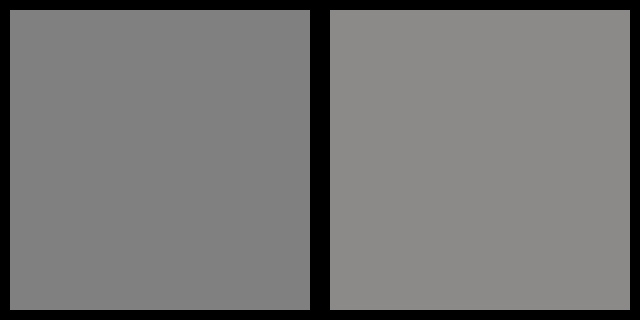The tint of eyeglasses depends on a number of factors.
Modern eyeglasses are not made of glass but of a polycarbonate polymer with a high refractive index. These high refractive polymers contain aromatic moieties which make them sensitive to short wavelength light, causing them to yellow over time when exposed to UV light. Light stabilizers added to the polymer retard this yellowing, but cannot completely prevent it over time. Therefore, your glasses will develop a yellow tint over the years.
Quality eyeglasses have anti-reflective coatings which reduce the amount of light reflected at the surface. However, their effect depends on the wavelength of the light and the viewing angle. The reflected light then gets colored and the transmitted light gets tinted with the opposite hue. Therefore, even new glasses with an anti-reflective coating will show a slight tint.
Most quality eyeglasses also contain a UV-absorbent, which may be in the polymer itself, in an extra coating or in both. This UV-absorbent protects your eyes from UV light, which is a good idea, because UV light causes aging and yellowing of your eye lens over time. However, these UV-absorbents do not provide a sharp cutoff at a specific wavelength, but have an absorption tailing to longer wavelengths into the purple and blue part of the spectrum, Therefore, they will inevitably cause a slight yellow tint of the transmitted light.
Alan has already pointed out that the human visual system is good in compensating such a color tint and this is particularly the case for a yellow tint. The reason is that such compensation capability is needed for a physiological reason. Human tissue is sensitive to UV light and the eye’s retina needs UV protection or it would get sun burnt. This UV protection is provided by a UV-absorbent present in the eye lens, which has the same shortcoming as the UV-absorbent in eyeglasses: its light absorption extends into the blue part of the visible spectrum and thus causes a yellow tint of the transmitted light. You can find details at handprint : light and the eye, a website that provides a wealth of information on human vision.
If you wear your glasses all day long, your visual system will compensate the color tint of your glasses, just as it compensates the color tint caused by the UV-absorbent in the eye lens, so you will have almost the same color perception as without glasses.
I use two pairs of glasses, both with progressive lenses by Zeiss. The first one has full correction for view at infinite distance and has a UV filter and an anti-reflective coating. The second one are so-called office eyeglasses with reduced correction for view to at most 5 m and an enlarged middle section for a viewing distance of about 80 cm. The second one has an additional blue light filter and therefore has a distinctive yellow tint.
In direct back to back comparison, the yellow tinted office eyeglasses provide a color perception of an approximately 200 K higher color temperature.
However, the edits I have made wearing these tinted glasses do not deviate notably from the edits I have made with the other glasses. Apparently, when using the more tinted glasses for some time, the tint gets sufficiently compensated by my brain to not affect the results.
And of course, looking for objects in a scene that you perceived as neutral white or gray and adjusting color temperature and tint based on color picker readings at these spots helps a lot in getting your colors right.
![]() ) and that slight tint is due to compromises of weight, thickness, anti-reflection-coating etc… and cannot be avoided.
) and that slight tint is due to compromises of weight, thickness, anti-reflection-coating etc… and cannot be avoided.![]()
